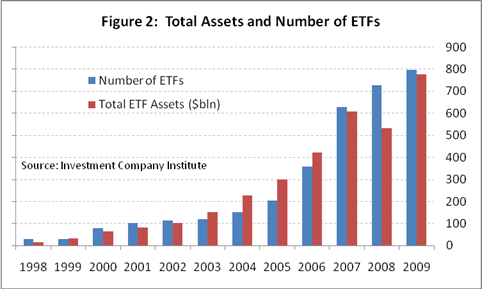Exchange Traded Funds ETF Providers in Canada
Post on: 10 Май, 2015 No Comment

An Exchange Traded Note (ETN) promises to pay a return based on the performance of an underlying index or other benchmark.
This section is a very brief overview of the subject matter. As with all other investment decisions, investors considering investing in Exchange Traded Notes (ETNs) should seek their own financial, legal and tax advice prior to purchasing any securities.
ETNs should not be confused with ETFs. An ETF, like a mutual fund, holds a basket of securities to which the ETF holder has indirect ownership. ETNs are not funds. An ETN is a senior unsecured debt obligation of a financial institution. It is simply a note that promises to pay a return based on the performance of an underlying index or other benchmark. As such, the investor is exposed to credit risk .
1 Advantages of ETNs
The main advantages of ETNs are two-fold:
ETNs can provide access to specialized markets, strategies and asset classes that may be difficult to achieve with other types of investments. For example, they may offer convenient cost-effective exposure to targeted asset classes such as commodities or currencies.
Secondly, they are generally immune to tracking error. When a bank issues an ETN, it promises to pay the total return of the underlying index or other benchmark (minus applicable fees) either at full maturity or early redemption (subject to a one-time redemption charge).
2 Similarities to ETFs
ETNs are similar to ETFs in several ways:
An ETN’s performance is tied to an underlying index or benchmark. However, as noted above, while some ETFs fall short of their benchmark, ETNs typically do not exhibit tracking error.
Also, like ETFs, the ETN vehicle offers intra-day trading on an exchange.
Thirdly, just as ETFs are designed to track the net asset value of their underlying basket, ETNs have an indicative value that reflects the performance of the underlying index or benchmark. Similar to ETFs, the arbitrage mechanism and creation/redemption process helps to keep the market price of ETNs close to their indicative value. As is the case with units of ETFs, ETNs can be created and redeemed in large blocks by designated brokers. But unlike the majority of ETFs, which exchange underlying assets for ETF units, ETNs are created and redeemed with their cash equivalents.
Also as is the case with ETFs, greater liquidity of the ETN and of the underlying index or asset class generally contributes to the narrowing of the spread between bids and offers in the marketplace and tends to improve pricing.
3 Differences from ETFs
ETNs are often grouped together with ETFs because both vehicles trade on exchanges, but they are fundamentally different structures and have several key differences.
ETNs are a type of debt security that promise a return linked to an index or other benchmark, but unlike ETFs, ETNs do not hold assets to replicate the performance of the underlying index.
Secondly, ETN investors are exposed to credit risk in the event that the issuer of the note fails or defaults on the note. Payments made on maturity or upon redemption depend on the ability of the ETN issuer to satisfy the obligation.

While ETFs may exhibit tracking error in that ETF returns may differ from the underlying index being tracked, ETNs are obligated to deliver the total return of their indexes minus only the fee — the issuer charges an annual fee that accrues through the term of the ETN. As a result of this fee, the return will be lower than that of the underlying index or benchmark.
4 Risks of ETNs
As noted above, there are several risks associated with ETNs. Among them are:
- Credit Risk – ETN investors are exposed to the credit risk of the issuer and any negative developments related to the issuer may result in substantial volatility and potentially significant dislocation between the indicative value and market price of the ETN
- Market Risk – ETNs are not principal protected; the value of the ETN can change as its benchmark value changes with market forces, which can result in a loss of principal
- Liquidity Risk – while ETNs are exchange traded, a trading market for a particular note may not develop
- Holding Period Risk – if leveraged, performance over long periods can differ significantly from the stated multiple of the performance of the underlying benchmark for a stated period
- Call or Early Redemption Risk – some ETNs are callable at the issuer’s discretion, and such calls may adversely affect the value of the notes
5 Questions to Ask
Some questions you may wish to ask in consultation with your legal, financial and tax advisors:
- Who is the issuer and what is its credit rating?
- What index or benchmark does the ETN track and is there sufficient information available to adequately assess the risks?
- Is the ETN callable by the issuer?
- Does the ETN offer leveraged exposure to the underlying benchmark, and if so, how frequently does it reset?
- What fees and costs are associated with the ETN?
- What are the tax implications of the ETN investment?
All content (including any links to third party sites) is provided for informational purposes only (and not for trading purposes), and is not intended to provide legal, accounting, tax, investment, financial or other advice and should not be relied upon for such advice. Please seek professional advice to evaluate specific securities or other content on this site. This information is provided for information purposes only. Neither TMX Group Limited nor any of its affiliated companies guarantees the completeness of the information and we are not responsible for any errors or omissions in or your use of, or reliance on, the information. The information provided is not an invitation to purchase securities listed on Toronto Stock Exchange and/or TSX Venture Exchange. TMX Group and its affiliated companies do not endorse or recommend any securities referenced here. © TSX Inc. a wholly owned subsidiary of TMX Group Limited. All rights reserved. Do not sell or modify this document without TSX Inc.’s prior written consent.
***S&P is the trade-mark of Standard & Poor’s Financial Services LLC, and TSX is the trade-mark of TSX Inc.














